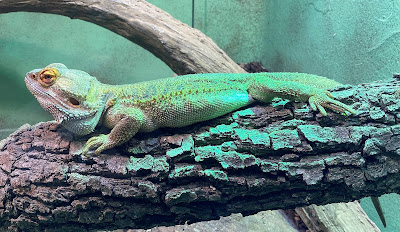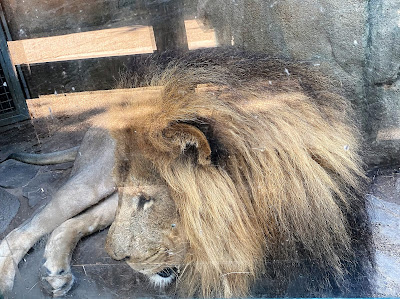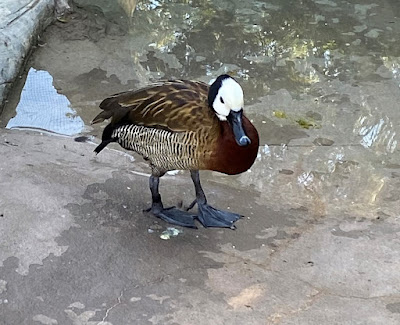November 29, 2021
Since we were flying home out of Houston, we spent our last day of our Southern Texas trip there and managed to cram quite a bit in.
We began the day with a drive-by visit to Rice University. The average GPA for admission to this elite private school is 4.12. It has an acceptance rate of 8-10% and an impressive graduation rate of 95%, which I would guess is due in part to the 6:1 student-faculty ratio. About 7,200 students attend Rice, with about 55% of those being undergrads and 45% being grad students. Tuition is $51,000+ for undergrads.
Less than a mile away from Rice is the Houston Zoo, a 55-acre park with over 600 species of animals. It is relatively small in comparison to zoos like New York City's Bronx Zoo (265 acres), the National Zoo in Washington D.C. (163 acres), or the San Diego Zoo (100 acres), but Wikipedia says it is the second most visited zoo in the United States, or at least it was in 2017.
Cute door handles. (Can you see Bob in the reflection?)
They already had Christmas decorations up, which added some festivity to our visit:
One of the things that impressed us what that nearly ALL of the animals were out and about. We have had plenty of zoo trips where we searched cages for any signs of life and never found anything.
An otter and a meerkat, looking right at us.
The zoo also has lots of great photo opportunities. Here's the first one.
Elephants didn't used to appeal to me that much, but having seen elephant herds in the wild and learning more about their intelligence and sensitive natures have made me a huge fan. However, it is a little sad to see them confined to a cage in a zoo.
A second photo opportunity!
Bob loves the reptile and amphibian exhibits. Here is an Anegada Island iguana . . .
a Rowley's palm-pit viper . . .
a Panamanian gold frog, and a black-legged poison dart frog. Other than the bearded dragon, I haven't heard of any of these!
Zoos are great for seeing animals from the other side of the world, such as a patas monkey from central Africa . . .
white-cheeked gibbons from the Cambodia/Thailand region . . .
and a Cape vulture from South Africa.
They are also good for seeing animals from our own country. The mountain lion exhibit gave me one of the best views of a mountain lion I've ever had.
This black bear (I know it is brown, but it is still a black bear) is actually native to Texas.
There are more foreign than local animals in most zoos, however. This clouded leopard is from the Thailand - Indonesia region.
Lucky us! The male lion was lying right next to the glass!
The females weren't very far away.
The jaguar was also happy to be seen.
The cheetah, on the other hand, was shy, as cheetahs are. I had to settle for a hug from a statue.
At first glance you might thing this Central African okapi is related to a zebra, but it is actually the only living relative of the giraffe. Fun fact: Their tongues are so long that they can lick their eyeballs.
In contrast to an okapi, a zebra's head is much more like a horse's head than a giraffe's head.
The zoo is working with conservationists in the Galapagos Islands to help save the iconic Galapagos tortoise. (Three-and-a-half months later, we will see these IN THE GALAPAGOS ISLANDS!)
More zoo décor:
Our arborist son wanted a picture of bald cypress trees, which grow these woody protuberances, called "knees," around the base. This photo is for him.
Recently I've been a fan of the Big Bear Lake Bald Eagle Live Nest Cam, so I had to make sure to see the zoo's bald eagle, which has a nice nest, but no mate--yet. The zoo is looking for one.
Even better is the name of these birds: Roseate spoonbills (which we saw in the wild earlier on this trip).
VERDICT: Definitely a zoo worth visiting!












.JPG)














.JPG)








.JPG)


.JPG)






.JPG)

The Houston Zoo really had some nice exhibits: the one with the anteater (and other animals) was particularly good. As you've pointed out, Houston turned out to be much more fun than we originally surmised the first time we visited.
ReplyDelete